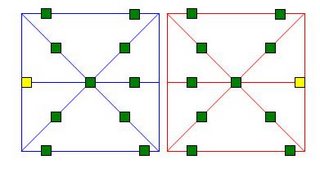He must have been about 12 when he invented this game. It required a smooth floor (no designs), chalk and some pieces of scrabble. We drew on the floor a battle ground that looked like this

Two teams are indicated as the adjacent Red and Blue battle squares. The small squares in green are soldiers. The yellow squares are Politicians.
Objective of the game: Clear your opponents pieces off the board!
Playing it is a bit like carrom (but I liked it a whole lot more then carrom) - use your pieces to hit the opponent's and if your piece goes off the boundaries, your opponent's comes back in.
This is the simple version of the game - there's no politician.
The more complicated version was... well, more complicated! I don't even remember all the rules. When I consulted with The Inventor, he said we had to make up rules as we played to keep the game from disintegrating! But here are the rules as I remember. If you want to play this, go ahead, and just make up the rules!
Each soldier here is made by stacking 3 scrabble pieces. He has a similar stack of ammunition next to him. You hit the enemy soldier with the ammunition from your soldiers. If you scatter 2 or more scrabble pieces from the enemy's body, the enemy is ‘dead’ (otherwise just wounded) and his scattered body and ammo become yours! This is where the complication comes in - Is a wounded soldier allowed to attack, or just stay there? And the weapons you acquired from a killed enemy were not for immediate use. They became "auxiliary" weapons (I had heard the word for the first time), and there were some rules about when to use them - such as a certain level of depletion of your own ammo. As I said, just make up the rules as you go along!
The politician, as you can see is heavily protected. His scalp is the ultimate prize.
We had loads of fun playing this on lazy summer afternoons, unaware of the addictive powers of the television and internet.
And if you have more kids, just draw a battle square for each kid!
When I started writing this, what really intrigued me was – a 12 year old thinking of placing the politician behind flanks of soldiers, making him the ultimate target (and not a very popular figure in the impressionable mind of his sibling). On second thoughts, not much of a surprise. This was around the time of Indira Gandhi’s assassination, and the Inventor would have soaked up dozens of dinner time political talk.



